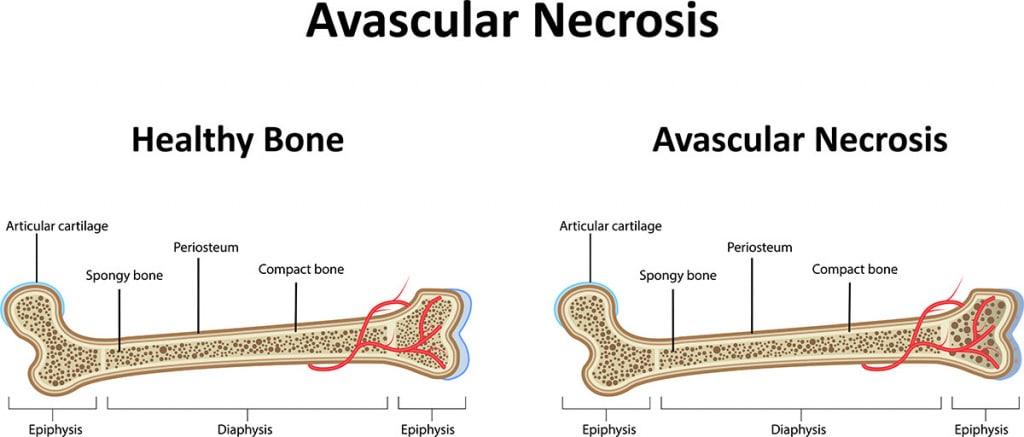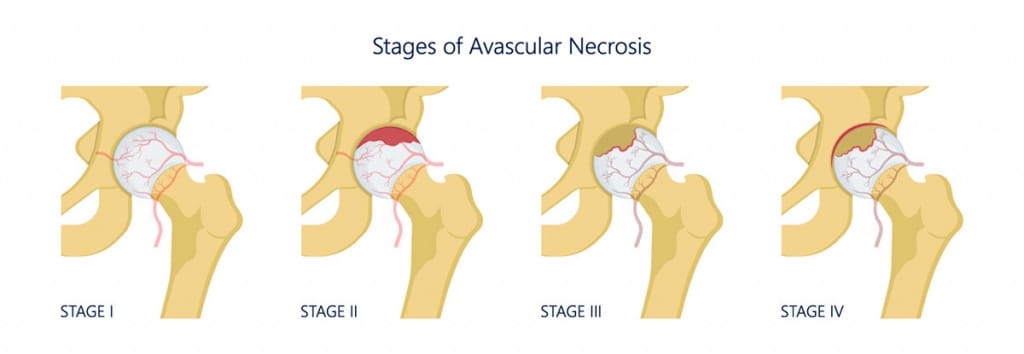The most common causes of avascular necrosis would be:


If the necrosis is of low grade, some evidence suggests that it can be reversed. However, in most cases, it is irreversible and typically requires surgical intervention to remove the necrotic for recovery.
Unfortunately, avascular necrosis will not go away unless treated by a medical practitioner or surgeon. In fact, if left untreated, it may worsen with time. Eventually, the bone can collapse or the bone may lose its smooth shape, which leads to severe arthritis. Post-treatment, recovery time may take up to 3 months or more for complete recovery.
Avascular necrosis is not an infectious disease and does not travel through the body like an infection. As a result, it is localised and does not spread to other bones or organs in the body.
In the early stages of avascular necrosis, patients are often asymptomatic, which is what makes this disease so insidious.
However, the initial signs of necrosis of bones would usually be pain. At first, the pain is only upon exertion and pressure. As the disease progresses, however, the pain may be constant. The bones involved may subsequently cave and collapse inwards, rendering severe pain and inability to use the joints.
The progression of avascular necrosis is stage into the following categories:

Once you suspect any signs of avascular necrosis, you should see a doctor immediately to prevent it from progressing to late stages.

Chances of osteonecrosis are higher in patients with the following risk factors.
Your orthopaedist will usually ask for a detailed history, followed by film X-rays and MRIs to effectively detect avascular necrosis.
Mild cases and early stage avascular necrosis may be managed with non-steroidal anti-inflammatory drugs.
However, avascular necrosis is often managed via surgical intervention.
Through the removal of the inner layer of your bones involved, pain is reduced. The extra space within the bones also stimulates healthy bone tissue and new blood vessels to be produced.
Areas affected by avascular necrosis are often weakened. By transplanting bone into the region, the affected region is strengthened. Bone used for the graft is often a section of healthy bone taken from another part of your body.
The affected bone is reshaped by removing a wedge of bone above or below a weight-bearing joint. This helps shift your weight off the damaged bone. Bone reshaping might enable you to postpone joint replacement.
In late-stage disease, the diseased bone has collapsed. Most other treatments often end up ineffective and surgery may be necessary to replace the damaged parts of your joint with plastic or metal parts.
Prevention is key when it comes to this debilitating disease. The best way to prevent avascular necrosis would be to:

Avascular necrosis is a disease that causes temporary or permanent loss of blood supply to the bone, causing the bone tissue to die and collapse. If you experience common symptoms, such as joint pain and a limited range of motion, consult your orthopaedist immediately for proper diagnosis and treatment.
